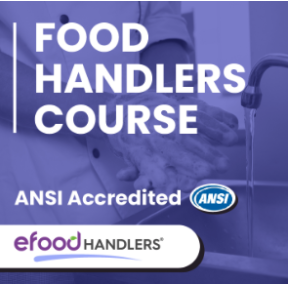The PASS Training Marketplace
Maryland eFoodHandlers - Basic Food Safety Training
Maryland eFoodHandlers - Basic Food Safety Training
Product Description
FoodHandlers® is a National, ANSI-Accredited Food Safety Training Provider.
Please note: Your local jurisdiction may have other requirements. Check with your local authority.
What is food handlers training?
Please note: Your local jurisdiction may have other requirements. Check with your local authority.
What is food handlers training?
Food handlers training, also called food safety training, teaches employees in restaurants and other food service facilities the basics of safe food preparation. Food safety is so important that three federal agencies, states, and local health authorities work together to create food handler training standards.
The exact content and requirements for food handlers training vary by location. Still, it usually includes cooking times, safe heating and cooling, sanitization standards, risk factors for foodborne illness, and other crucial food safety guidelines.
What do I get at the end of food handlers training?
What do I get at the end of food handlers training?
You will receive a Maryland food handlers card immediately after completing your training. If you take a county-specific training program, your certificate will include your county's name. Your certificate will also feature the ANAB logo if you complete an ANAB-accredited course.
What’s the difference between a food handlers card and a food handlers certificate?
What’s the difference between a food handlers card and a food handlers certificate?
The main difference is the size of the document. A food handlers card is designed to fit in your wallet as a convenient way to show you hold an approved food handlers certificate.
A food handlers card and a food handlers certificate prove that you have satisfied the necessary food safety training requirements to work in a food service establishment.
Enroll in our Maryland course today!
Enroll in our Maryland course today!
eFoodHandlers® is a National, ANSI-Accredited Food Safety Training
Approval
This food handlers card holds the ANSI National Accreditation Board food handler training program accreditation (ASTM e2659-2018).
Approval
This food handlers card holds the ANSI National Accreditation Board food handler training program accreditation (ASTM e2659-2018).
Purpose
The purpose of our food handlers card training is to provide food handlers with the information they need to handle food safely. This information may include content specified by state or local regulations.
The purpose of our food handlers card training is to provide food handlers with the information they need to handle food safely. This information may include content specified by state or local regulations.
Scope
This program will teach or reiterate responsible food handling principles to the learner.
This program will teach or reiterate responsible food handling principles to the learner.
Learning Objectives
(Effective date April 29,2020)
(Effective date April 29,2020)
By the end of this course, you will be able to:
- Recognize how food can cause illness or allergic reactions.
- Prevent contamination of food and food-contact surfaces with the hands and body.
- Identify which symptoms or illnesses must be reported to a manager.
- Use time and temperature control throughout the flow of food.
- Maintain a clean environment for food preparation and service.
Outcomes
After you pass the test, you’ll receive your food handlers card.
After you pass the test, you’ll receive your food handlers card.
Requisites to earn certificate
In order to earn a certificate, you must complete the course and pass the test.
In order to earn a certificate, you must complete the course and pass the test.
- Validity
- 3 years
- Final Exam
- Yes
- Final Exam Passing Score
- 70%
- Certificate
- Yes
- Average Rating
- / 0 Reviews
Foodborne Illness Awareness Chapter 1
Foodborne illness awareness is crucial for preventing food poisoning. Each year in the United States, approximately 48 million cases of foodborne illness occur, leading to 128,000 hospitalizations and 3,000 deaths.
Remember to practice proper food safety by washing hands, separating raw meats, cooking to the right temperature, and promptly chilling perishable foods.
Person-In-Charge Role and Responsibilities Chapter 2
Regarding basic food safety, the person in charge must ensure proper hygiene practices, including handwashing and sanitizing surfaces.
Additionally, they should oversee food storage, handling, and cooking processes to prevent contamination and promote safe consumption.
Proper Handwashing Chapter 3
Proper hand washing involves thoroughly wetting hands with clean, running water, applying soap, and scrubbing all surfaces (including between fingers and under nails) for at least 20 seconds.
Rinse hands well under running water and dry with a clean towel or air dryer.
Health and Hygiene Chapter 4
Health refers to an individual’s physical, mental, and emotional well-being.
Hygiene, on the other hand, involves practices that maintain cleanliness and prevent the spread of disease.
Cooking Temperatures Chapter 5
When cooking meat or eggs at home, remember these important temperatures:
- Eggs and all ground meats must be cooked to 160°F (71°C).
- Poultry and fowl should reach 165°F (74°C).
- Fresh meat steaks, chops, and roasts are safe at 145°F (63°C).
Use a thermometer to check temperatures and ensure safe food preparation.
Temperature Danger Zone Chapter 6
The temperature danger zone for basic food safety is typically between 40°F (4°C) and 140°F (60°C).
Bacteria thrive and multiply rapidly within this range, significantly increasing the risk of foodborne illnesses.
Contamination & Cross-Contamination Control Chapter 7
Contamination refers to harmful food substances (such as microorganisms or allergens).
Cross-contamination occurs when these contaminants transfer from one surface or food item to another, potentially compromising safety.


